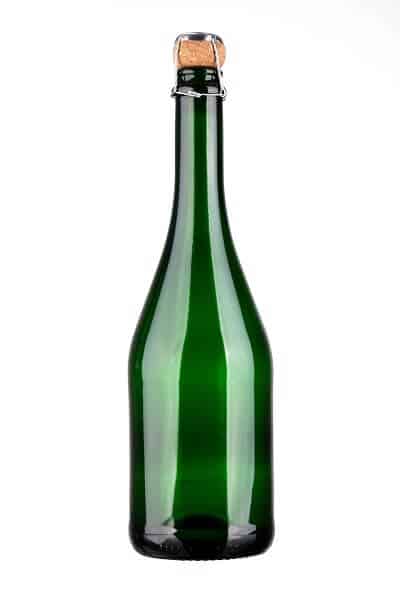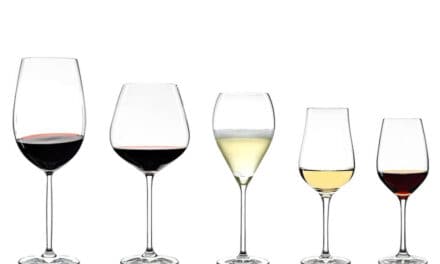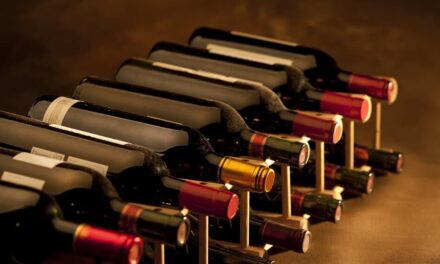Wine bottles are quite different from bottles for other beverages. Besides their rather unusual volume of 0.75 liters, they have unique shapes and special colors. But why is that? Why are wine bottles green?
Wine bottles are green to protect wine from sunlight, specifically UV frequencies. UV light can start chemical reactions in the wine that cause changes in color and aromas and, eventually, spoilage. Green glass shields the wine from harmful light frequencies, prevents chemical reactions, and thus helps keep the wine fresh.
So it is fair to say that green glass works similarly to sunglasses or sunscreen. But not all wines need this kind of protection. Many come in clear, colorless bottles, and others even come in darker glass. To better understand the purpose of colored bottles, let’s discuss the different types of wines and the optimal bottle colors for them.

Traditional Green Bottle for Champagne Sparkling Wines
WHICH WINES COME IN GREEN BOTTLES?
Typically, red wines come in green bottles, but some exceptions exist. Besides, there is not one standard hue of green. Instead, vintners use different hues of green for their wine bottles:
- Champagne sparkling wines typically come in Champagne-green bottles. It is a vibrant color, offering protection against sunlight and recognition value. So, it is also a marketing tool.
- Many vintners worldwide use antique-green for red wines that are made for extensive aging. It is darker than Champagne-green and thus offers an excellent level of protection for wines that age for decades before being opened.
- Amber-colored glass is even better for this purpose. Actually, it is rather brownish than green, but many bottles from amber-colored glass appear greenish in the right light.
- A significantly lighter hue is dead-leaf green, which is a yellowish shade of green. It offers less protection against sunlight but is nevertheless used by many winemakers. Especially Bordeaux wines but also Burgundy wines come in dead-leaf green bottles.
WHICH WINES COME IN BLACK BOTTLES?
Black bottles are relatively rare in the wine industry, but you can find them. They are even better at protecting wine from sunlight but are not as pretty as green glass bottles. Thus, black bottles only make sense for wines made for decades of bottle-aging.
Especially fortified wines such as Port or Madeira belong to this category. These strong wines often improve over the course of 30, 40, or 50 years when stored at optimal conditions. To offer them the best level of protection, many Madeira vintners choose black glass when bottling their wines.
WHICH WINES COME IN BLUE BOTTLES?
Blue bottles might be even rarer than black bottles. And without a doubt, blue glass is primarily a marketing tool. It has no benefits in terms of protection compared to green or brown glass. And for vintners who rely on tradition and reputation, blue bottles are simply too fancy. Thus, most wines in blue bottles come from modern wineries open to experimenting. One example that shocked wine lovers a couple of years ago is the blue wine by the Spanish company Gik.
WHY DOES WHITE WINE COME IN COLORLESS BOTTLES?
Most white wines are meant for immediate consumption. They have no aging potential, and thus, it does not make sense to store them for years before opening them. For most white wines, that is true. They do not need the same level of protection as red wines that are made for extensive aging. And thus, using colorless glass bottles for them is fine.
However, some winemakers follow different approaches, and many of them are rooted in tradition:
- Many vintners in Germany’s Mosel region bottle their white wines in green bottles.
- In the neighboring Rheingau, vintners follow an even less common tradition: They use brown bottles for their white wines. Their color is similar to the color of beer bottles.
- In Bordeaux, winemakers traditionally use light-green bottles for their white wines.
WHY ARE WINE BOTTLES GREEN? WHERE DOES THE COLOR COME FROM?
The green color in wine bottles comes from substances that producers add to the glass. Among them are the following materials:
- Iron oxide is the most common coloring agent for wine bottles. It creates a bluish-green hue.
- Chromium makes dark green or even black glass when added in high concentrations. When combined with iron oxide, the result is an emerald-green color.
- Copper produces lighter turquoise hues.
In the past, these materials often were present as impurities. So the color green was rather an accident than the desired result of purposeful action. But over time, wine lovers discovered that their favorite drink kept longer when stored in colored bottles, and thus vintners demanded colored bottles from glassblowers.
WHY ARE WINE BOTTLES SO HEAVY?
Besides the color, wine bottles have unique features that distinguish them from other vessels. One of them is weight. Wine bottles tend to have thick walls, making them heavier than bottles for water, beer, or other beverages.
Like the glass color, these thick walls were necessary to protect wine efficiently in the past. Especially sparkling wine could burst a thin bottle because of its internal pressure from CO2. But even for still wines, many winemakers chose robust bottles to avoid breakage when transporting their products.
Nowadays, the technical advantages of thick glass are not that relevant anymore. Bottles are much more stable with modern production methods, even with relatively thin walls. And from a cost perspective, thick bottles do not make much sense. The thicker the glass, the more expensive its production is. In addition, the weight of heavier bottles is reflected in higher transportation costs.
However, some vintners still use thick bottles for another reason. Just like a bottle’s label, its weight is a marketing tool. The reason is that many consumers connect weight with quality. Whether it’s a watch on the wrist, a luxury car, or a designer purse, a heavy item simply feels better and more valuable than a light one. With wine, it is not much different. Wine lovers tend to connect a heavy wine bottle with a better-quality wine. And vice versa, a light bottle might be considered cheap. Thus, winemakers still fill their wines into heavy bottles made from thick glass. In particular, wineries with a long tradition and a high reputation tend to follow this practice.
WHY DO WINE BOTTLES HAVE A DIMPLE IN THE BOTTOM?
You might have wondered why the bottle of a wine bottle is concave or, in other words: Why there is a dimple. There is no consensus among wine lovers about this dimple’s original purpose, officially called “punt”. However, there are many theories. Some originated in similar concerns as the bottle color or the weight.
First of all, the dimple makes the bottle’s bottom more stable. Especially for sparkling wine bottles, this was an essential benefit in the past. Bottles regularly exploded because of their high internal pressure from CO2. And the dimple made them less fragile.
Another reasonable explanation for the dimple in the bottom of a wine bottle is balance. For a long time, glass blowing was a manual process, and bottles never were perfect duplicates of each other. Sometimes, they had small bumps in the bottom, making them unstable when standing upright. By creating dimples in the bottom, glass blowers could avoid this problem and give it a better balance.
With modern production techniques, these two problems are solved. Wine bottles have standard shapes, and those with flaws are sorted out right after production. Nevertheless, other reasons explain why modern wine bottles still have concave bottoms. For instance, the dimple makes it easier to hold the bottle. Especially in high-class venues, waiters and sommeliers tend to pour wine while holding the bottle in one hand. When putting a thumb inside the dimple, they have a tighter grip and can control the pouring process better.
Finally, the dimple in a wine bottle’s bottom makes it easier to deal with sediments. These tiny particles are natural byproducts of winemaking. And although they are not harmful, it’s an unpleasant experience to taste them. Thus, wine lovers filter them out when serving the wine. With a flat bottom, the sediments would spread as soon as the bottle stood upright. But with the dimple, the particles collect in a small area close to the bottle’s wall. That makes it much easier to spot the sediments and prevents them from entering the glass when pouring the wine.
FINAL WORDS
Wine bottles result from careful consideration by both bottle producers and winemakers. Every aspect of their design has a specific purpose. And after reading this article, you can not only answer the question of why wine bottles are green. You can also explain why they are heavy and have a dimple in the bottom. Feel free to use this knowledge to impress your wine-loving friends when serving them a glass next time. Cheers!






